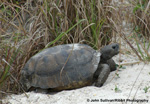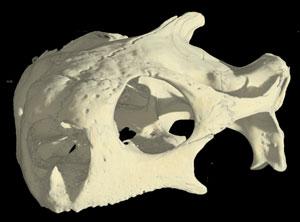Gopherus polyphemus, the gopher tortoise,  is a member of Testudinidae within Cryptodira. Testudinidae is a large and diverse clade of extinct and extant terrestrial forms, and includes well-known giant species such as the Galápagos and Aldabra tortoises. Testudinidae is closely related to the Old- and New-World pond turtles (Geoemydidae and Emydidae, respectively), but the relationship of these three close relatives to other turtles is unclear (e.g., Gaffney and Meylan, 1988; Joyce, 2007). There are four extant species of Gopherus, all of which inhabit North America (Ernst and Barbour, 1989; Bonin et al., 2006).
is a member of Testudinidae within Cryptodira. Testudinidae is a large and diverse clade of extinct and extant terrestrial forms, and includes well-known giant species such as the Galápagos and Aldabra tortoises. Testudinidae is closely related to the Old- and New-World pond turtles (Geoemydidae and Emydidae, respectively), but the relationship of these three close relatives to other turtles is unclear (e.g., Gaffney and Meylan, 1988; Joyce, 2007). There are four extant species of Gopherus, all of which inhabit North America (Ernst and Barbour, 1989; Bonin et al., 2006).
Gopherus polyphemus is a medium-sized tortoise whose carapace length may reach 30 cm (Ernst and Barbour, 1989; Bonin et al., 2006). The skull is relatively short, and exhibits distinct posterior temporal emargination (Ernst and Barbour, 1989). The carapace is oblong, flat-topped, and drops off abruptly on the sides and at the rear. The plastron is extensive and well-developed. The forelimbs are covered with large scales. The gopher tortoise is dark brown to gray-black dorsally and yellow to gray ventrally (Ernst and Barbour, 1989; Bonin et al., 2006).
Gopherus polyphemus is found in the southeastern United States from South Carolina to Florida, and extends into eastern Louisiana. It prefers sandy soil, and habitats range from broad-leaf forest to prairies and scrub (Ernst and Barbour, 1989; Bonin et al., 2006). The gopher tortoise digs long burrows in which to sleep, estivate, and hibernate. It is herbivorous, consuming mostly grasses and leaves, but will occasionally eat insects and bones. Females lay a single clutch, normally consisting of five eggs, once per year after an elaborate courtship ritual (Ernst and Barbour, 1989; Bonin et al., 2006). Gopherus polyphemus is listed by IUCN as vulnerable, and is under constant threat due to habitat loss resulting from human activity.

Literature
Bickham, J.W. and J.L. Carr. 1983. Taxonomy and phylogeny of the higher categories of cryptodiran turtles based on a cladistic analysis of chromosomal data. Copeia 1983:918-932.
Birkhead, R.D., Guyer, C., Hermann, S.M. and W.K. Michener. 2005. Patterns of folivory and seed ingestion by gopher tortoises (Gopherus polyphemus) in a southeastern pine savanna. American Midland Naturalist 154:143-151.
Bonin, F., Devaux, B., and A. Dupré. 2006. Turtles of the World. Translated by P.C.H. Pritchard. Johns Hopkins University Press, Baltimore MD.
Ernst, C.H. and R.W. Barbour. 1989. Turtles of the World. Smithsonian Institution Press, Washington DC.
Ferri, V. 2002. Turtles and Tortoises. Firefly Books, Willowdale, ON.
Gaffney, E.S. 1972. An illustrated glossary of turtle skull nomenclature. American Museum Novitates 2486:1-33.
Gaffney, E.S. 1979. Comparative cranial morphology of recent and fossil turtles. Bulletin of the American Museum of Natural History 164:1-376.
Gaffney, E.S. and P.A. Meylan. 1988. A phylogeny of turtles. In: Benton, M.J., editor. The Phylogeny and Classification of the Tetrapods, Volume 1: Amphibians, Reptiles, Birds. Clarendon Press, Oxford, pp. 157-219.
IUCN 2006. 2006 IUCN Red List of Threatened Species (On-line). Accessed 28 March 2007 at http://www.iucnredlist.org.
Jamniczky H.A. In press. Turtle carotid circulation: a character analysis case study. Biological Journal of the Linnean Society.
Jamniczky, H.A. and A.P. Russell. 2007. Reappraisal of patterns of nonmarine cryptodiran turtle carotid circulation: evidence from osteological correlates and soft tissues. Journal of Morphology 268:571-587.
Joyce, W.G. 2007. A phylogeny of Mesozoic turtles. Bulletin of the Peabody Museum of Natural History 48:3-102.
Moon, J.C., McCoy, E.D., Mushinsky, H.R. and S.A. Karl. 2006. Multiple paternity and breeding system in the gopher tortoise, Gopherus polyphemus. Journal of Heredity 97:150-157.
Orenstein, R. 2001. Turtles, Tortoises, and Terrapins: Survivors in Armor. Firefly Books, Buffalo, NY.
Pike, D.A. 2006. Movement patterns, habitat use, and growth of hatchling tortoises, Gopherus polyphemus. Copeia 2006:68-76.
Pritchard, P.C.H. 1979. Encyclopedia of Turtles. TFH Publishing, Neptune FL.
Reynoso, V.H. and M. Montellano-Ballesteros. 2004. A new giant turtle of the genus Gopherus (Chelonia : Testudinidae) from the Pleistocene of Tamaulipas, Mexico, and a review of the phylogeny and biogeography of Gopher tortoises. Journal of Vertebrate Paleontology 24:822-837.
Shaffer, H.B., Meylan, P., and M.L. McKnight. 1997. Tests of turtle phylogeny: molecular, morphological, and paleontological approaches. Systematic Biology 46:235-268.
Tuberville, T.D., Clark, E.E., Buhlmann, K.A. and J.W. Gibbons. 2005. Translocation as a conservation tool: site fidelity and movement of repatriated gopher tortoises (Gopherus polyphemus). Animal Conservation 8:349-358.
Links
Gopherus polyphemus page by the U.S. Fish and Wildlife Service
G. polyphemus page on the Animal Diversity Web (University of Michigan Museum of Zoology)










